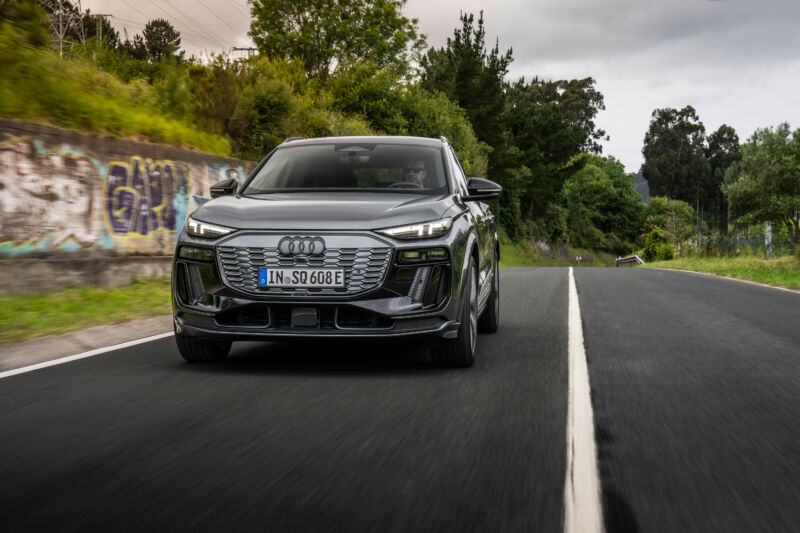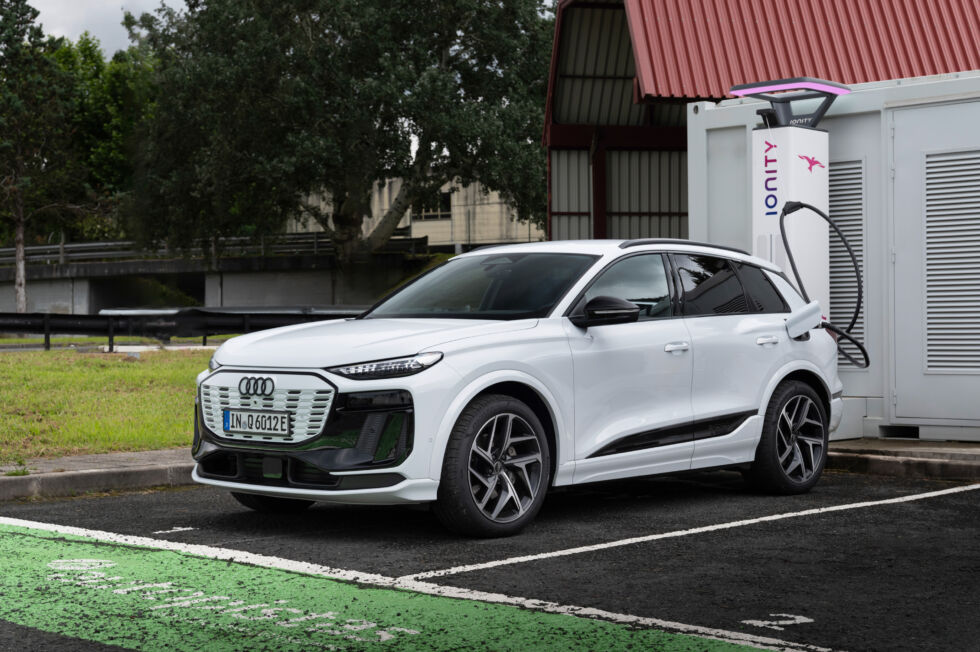
Audi
The arrival of the Q6 e-tron marks a significant milestone on the electric journey that Audi and its corporate siblings began in the wake of dieselgate, nearly a decade ago. Now, after developing electric vehicles based on its own gas-powered models, a cheaper VW platform, and a tweaked Taycan, the brand has led the development of a new platform just for electric vehicles, one that incorporates lessons learned from those earlier EVs.
We’ve followed the development of that Premium Platform Electric architecture and the Q6 e-tron for some time. Now, we’ve finally been behind the wheel.
Audi made its name with “quattro” all-wheel drive powertrains, and both versions of Q6 e-tron to be offered initially will use twin-motor, all-wheel drive powertrains—an asynchronous motor driving the front wheels and a permanent magnet synchronous motor at the rear. Both versions will use the same capacity 100 kWh (94.4 kWh net) battery pack, which operates at 800 V and DC fast-charges from 10–80 percent in 21 minutes.
The standard Q6 e-tron quattro has a nominal output of 422 hp (315 kW) and is capable of up to 456 hp (340 kW) when using launch control, which boosts this midsize electric SUV down the drag strip with enough vigor to hit 60 mph in 4.9 seconds (0–100 km/h in 5.1 seconds). Don’t drive like that, and about 307 miles (495 km) of range should be possible on a single charge, Audi says.

Audi
The SQ6 e-tron is the slightly spicy version, with an output of 483 hp (360 kW), peaking at 509 hp (380 kW) for brief bursts. This drops the launch control 0–60 time to 4.1 seconds (4.3 seconds to 100 km/h) and raises the top speed from 130 mph (210 km/h) to 143 mph (230 km/h), a fact that will be purely academic to anyone outside of Germany, and most people there, too. With larger wheels and more rapid acceleration, the SQ6 e-tron’s range drops to 276 miles (444 km) on a single charge.
Audi succeeded in finding a mostly alpine set of roads for us to test its newest EV. It probably hadn’t counted on such heavy rain, which, it turns out, does not just stay on the plain. The rather miserable conditions proved more intimidating to humans than the Q6 or SQ6.
Over the years, Audi has earned a reputation for setting up the handling of its cars in a particular way, even when using a shared platform. With the exception of its cars that wear the RS badge, that means a bias toward safe and predictable rather than anything too exciting. The good news is that an RS version of the Q6 is in the pipeline, and Sportback variants are coming, too, as well as a possible single-motor powertrain.
Driving impressions
Indeed, neither the Q6 nor SQ6 e-trons feels much like the new Porsche Macan from behind the wheel. Instead, they both feel like Audis from the driver’s seat, although the steering feel was sufficiently positive for me to make a note of it.
There’s a good one-pedal driving mode, engaged by moving the drive selector from D to B, which will regenerate up to 220 kW under deceleration. Whether you’re in this mode or you press the brake pedal, the first 0.25 G of deceleration will use the electric motors to regen, with the car blending in the friction brakes when stability or greater deceleration is needed.
While our test SQ6 was representative of the cars that will arrive in the US at the end of this year, the Q6 e-tron we drove was an EU-spec model, down about 40 hp (30 kW) on the standard model we’ll be offered. Despite that, the less-powerful car never felt particularly underpowered, even with a curb weight in excess of 5,200 lbs (2,360 kg). In efficiency mode, the Q6 e-tron will almost only ever use the rear motor, and even in this mode there was more than enough immediate torque to ensure this electric Audi can keep pace.
-
From now on, odd-numbered Audis will have internal combustion engines and even-numbered Audis will have electric powertrains.
Audi -
The Q6 e-tron is 187.8 inches (4,770 mm) long, 66.6 inches (1,692 mm) tall, and 76.3 inches (1,938 mm) wide.
Audi -
The Q6 e-tron has a 113.7-inch (2,889 mm) wheelbase.
Audi -
It’s not exactly boring to drive, but it’s not as fun as a Polestar 4.
Audi
Even with its more prodigious output, the SQ6 e-tron was an easy fast car to drive slowly. Whoever calibrated the one-pedal throttle map did a good job here, making it easy to add or subtract a mile an hour here or there with a flex of your ankle.
For highway driving, it’s often more efficient to coast between bursts of power—you don’t have to regenerate that which you don’t deploy, say the engineers—and the SQ6 (and Q6) glides nearly effortlessly with the drive selector in D if there’s any sort of downhill gradient. Regardless of whether you’re cruising on a highway or negotiating traffic in town, the driving experience is a more polished one than the Q8 e-tron, adapted as it is from an internal combustion model, or the Q4 e-tron, which uses the cheaper VW-led MEB platform instead.
In addition to more power and larger wheels, the SQ6 e-tron features new tuning for the adaptive air springs, which oddly seemed more comfortable for passengers when set to Dynamic rather than Comfort, perhaps because the former setting was suppressing body roll. Some of that behavior will be thanks to the domain controllers that have replaced dozens of black boxes, consolidating their functions in a handful of powerful automotive computers.
Tied together by Ethernet and overseen by a backbone computer, one domain controller handles vehicle dynamics, another the driver assistance systems, a third the climate control, lighting, and convenience functions, with a fourth computer responsible for infotainment.




















+ There are no comments
Add yours